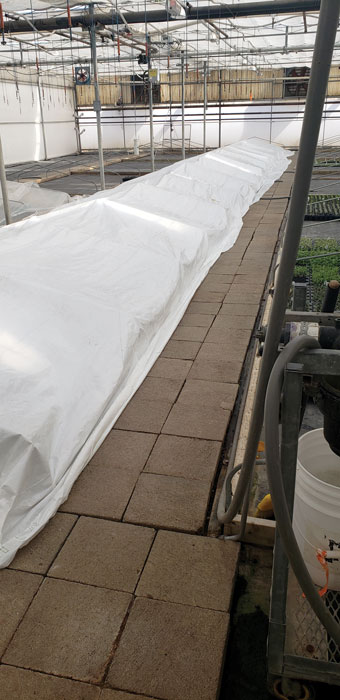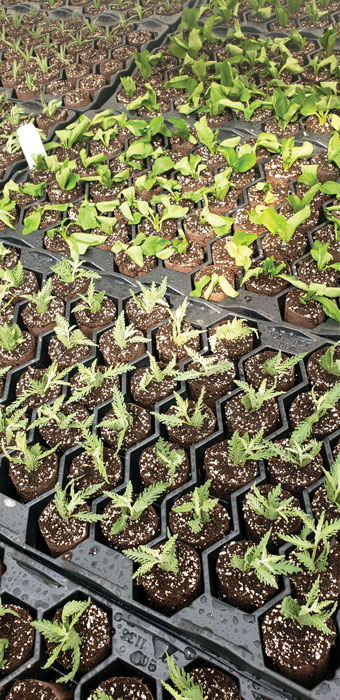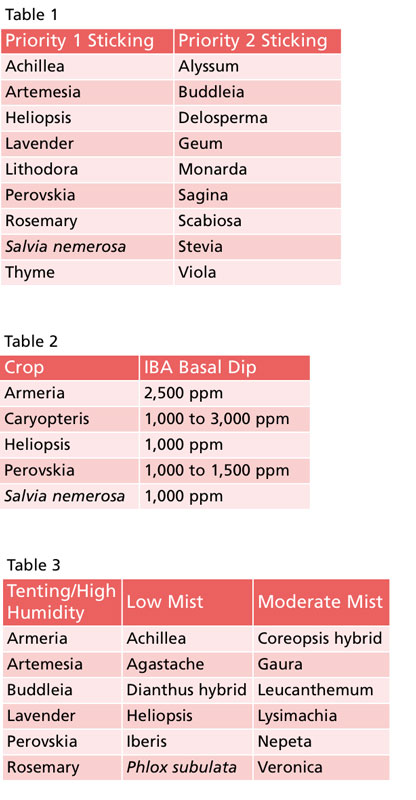1/1/2020
Perfecting Perennial Propagation
Chris Fifo

My earliest memory of plant propagation was in second grade. I was taking cuttings off my mom’s Swedish Ivy and sticking them in a glass of water. I loved watching them grow roots. My passion for propagation had evolved by the fifth grade and I was propagating spider plants and giving them to teachers. I’ve come a long way since then and my career has focused on perennial propagation and production.
Receiving unrooted cuttings
The same protocols go for receiving perennials as they would for any other unrooted material.
• Be aware of the temperature in the box. A digital probe thermometer can be stuck through the box before you even open it, or more commonly, an infrared thermometer can be used after the box is opened. (IR thermometers are only $20 and are a must-have for any greenhouse. These have so many applications). Take note if the temperature seems out of spec.
• Unpack cuttings in a low-light, high-humidity environment. You must do everything possible to prevent (additional) moisture loss from the cuttings.
• Inspect cuttings for signs of disease, pests, excessive wilt, etc.
• Sort varieties by priority for sticking (Table 1). This is critical if you’re unable to stick all of the cuttings the same day.
• If cuttings need to be held, research has shown the best method for storage is to open the bags (or place cuttings in a tray) and place them in a cooler (45 to 50F/4 to 10C) with mist or fog. The goal is to get the cuttings started re-hydrating while they’re waiting to be stuck. (DO NOT open bags and place in a cooler without humidity. This will further dry and stress the cuttings.)
Pictured: A common tenting setup.
Media
Everyone has seen cultural recommendations that say “use a well-drained media.” This is absolutely critical for perennial propagation.
Think of it this way … if cuttings are stuck into saturated, muddy media, what encouragement do they have to send out roots to look for water? The tendency would be to grow excessive callus, which will inhibit rooting.
 Pictured: A well-drained media drying slightly in propagation.
Pictured: A well-drained media drying slightly in propagation.
The importance of media starts at tray filling and one of the most important people in propagation is the person filling the trays. Media should be loosely filled into the trays, not packed in. Likewise, if using Elle Plugs, every effort should be taken to not pack the rolls tight. The media used should contain an ample amount (25%?) of “plug-grade” perlite. Coarse perlite doesn’t get evenly distributed in a liner-size tray or Elle Plug to be as effective.
When wetting up the trays, media should be watered to a 4—wet, but not saturated to a 5. We want to encourage rooting by providing an abundance of pore space.
Sticking cuttings
• Do not stick wilted cuttings! Simple concept, but often not easy to execute.
• Use a rooting hormone! Most perennials benefit from use of a rooting hormone. The traditional method for application is a basal dip in rooting powder before sticking. Today, more growers are using potassium IBA (KIBA) salts and doing a post-sticking sprench.
This works great for the majority of perennials and is saving growers on labor. The key points are to use a relatively low rate of 250 to 300 ppm (higher than 500 ppm can cause phyto) and high volume (minimum of 4 gal./100 sq. ft.). All cuttings can be stuck and then watered in with the KIBA solution. The use of a “wonder waterer” is perfect. Backpack sprayers aren’t effective for applying adequate volumes on a large scale.
There are a number of perennials that require a higher rate of IBA application (Table 2). For these, the basal dip using powder or liquid IBA is beneficial. Crops that are still in propagation at Day 7 can receive a second sprench of KIBA if desired.
l Apply Pageant Intrinsic fungicide as a spray the day after sticking. This product has been proven to improve rooting on all varieties tested. Believe it! I’ve been asked if this can be applied in combination with the KIBA. Yes, it can, but you use more chemical than is necessary to get the benefits.
Rooting and mist programs
This is the critical phase. You cannot just “set it and forget it.” I see this too often. When using booms, it takes regular monitoring and adjustment throughout the day. Even VPD programs need regular adjustment.
The goal: apply enough mist to keep the cuttings from wilting too much and little enough to keep the media from gaining moisture. The finer the mist the better. Fog is even better!
 In general, perennials prefer lower mist as compared to many annuals. Use a more frequent mist cycle until the cuttings are fully hydrated (36 to 48 hours) and then reduce the mist as quickly as possible—just enough to keep them from wilting too much (a little wilt isn’t a bad thing; Table 3).
In general, perennials prefer lower mist as compared to many annuals. Use a more frequent mist cycle until the cuttings are fully hydrated (36 to 48 hours) and then reduce the mist as quickly as possible—just enough to keep them from wilting too much (a little wilt isn’t a bad thing; Table 3).
Beyond mist, tenting has become a popular option. After cuttings are rehydrated, they’re placed in white plastic or reemay tents using conduit or PVC piping as a frame. The goal: keep the moisture off of the leaves, maintain a very high humidity and allow the media to dry slightly.
Recently, I visited a grower who was having great success with some of the more difficult perennials—lavender, rosemary, perovskia. He was doing it on the floor using only tents. No automatic watering. No fancy structures.
I saw his prop area at 3:00 p.m. one September afternoon. Many of the cuttings under his white plastic tent, which he keeps tightly sealed, were slightly wilted (more than I would wilt a cutting). I asked if he was going to mist them again and he said no. He mists by hand three times per day and then seals his tent (Figure 1).
He noted the sun was going down and the relative humidity was rising. In the morning, the cuttings would be fully turgid. I noted that his media had a lot of perlite and was just starting to turn light brown. Success!
So if you’re having difficulties rooting perennials:
1. Make sure you’re getting your cuttings rehydrated and you’re using IBA and Pageant Intrinsic within 48 hours.
2. Allow your media to dry slightly (excessive callus is a good indication of too much water).
3. Reduce the mist as quickly as possible. GT
Chris Fifo is a Product Representative for Darwin Perennials and Kieft Seed.